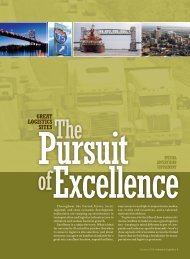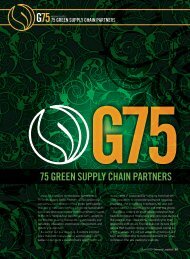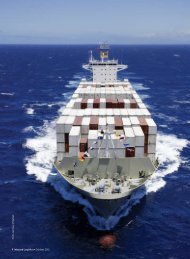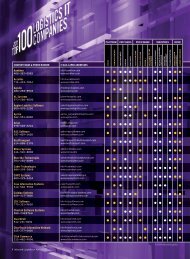Trucking Executive Thought Leaders - Inbound Logistics
Trucking Executive Thought Leaders - Inbound Logistics
Trucking Executive Thought Leaders - Inbound Logistics
- No tags were found...
You also want an ePaper? Increase the reach of your titles
YUMPU automatically turns print PDFs into web optimized ePapers that Google loves.
Sponsored EditorialOne key step to finding answers to any logisticsproblem is knowing the right questions to ask.<strong>Inbound</strong> <strong>Logistics</strong> asked three executives atleading motor carriers for their perspectiveson the important transportation challenges andopportunities impacting your business.These trucking executive thought leaders can giveyou insight into keeping your shipments moving.<strong>Trucking</strong><strong>Executive</strong>THOUGHTLEADERSChris KaneChief Customer Strategy OfficerKane Is Able Inc.Lee MillerPresidentMiller TransportersRick O’DellPresident and CEOSaiaSeptember 2010 • <strong>Inbound</strong> <strong>Logistics</strong> 1
QQ: The current crunch in trucking capacity hasmade mainstream news lately. How should thetransport industry solve this problem?Kane: The truth is there is no capacity shortage.Also, there are plenty of truck drivers, even afterwe lose 100,000 drivers through CSA 2010, asindustry experts predict. The problem is notcapacity or manpower or the number of tractortrailers or how much weight they’re allowedto carry. The problem is that half the trucks inAmerica are driving around half empty. Why?Because small and mid-sized manufacturers lackthe scale to ship in full truckloads. So you endup with thousands and thousands of separate,inefficient lines of supply – all moving to thesame mass retailers.The waste inherent in such a model isshocking. We have got to wake up and starttreating our distribution infrastructure asshared infrastructure. Think of riders on theNew York subway. Nobody expects to ride intheir own personal subway car. If they did, thesubway would be big enough to shake everyapartment in New York, and it would cost$100 a day to get to work.trucking executive THOUGHT LEADERSfor example, to arrive on Tuesday instead ofMonday, the shipment could be consolidatedwith paper towels and arrive in a single truck.Right now, buyers don’t get rewarded for loweringfreight costs. Their job is to look for mustardat the lowest price. Reducing freight is the jobof the guy at the DC, and he has no idea aboutordering cycles. It’s a question of getting thesedepartments working together. It’s not an easyshift, but 3PLs can act as matchmakers.Q: This sounds like a major change. Is it actuallypossible?Kane: Collaborative distribution is not someidealist’s dream. We’re already making it workon a small scale here at Kane. But when fullyimplemented, it could revolutionize how wedistribute consumer goods by simply shippingfreight on fewer trucks and saving billions acrossthe CPG supply chain.Kane Is Able Inc. | 888-356-KANEinfo@kaneisable.com | www.kaneisable.comQ: You’re talking about collaborativedistribution. Hasn’t that been tried already?Kane: I’m talking about a much deeperand more radical change in supply chainthinking than consolidating cargo on the lastleg of the journey. Collaborative distributionneeds to go right to the heart of retailers’ andmanufacturers’ operations. It’s a fantasticopportunity to take trucks off the road andcut distribution costs by 35 percent. Gettingmanufacturers to warehouse their productswith other manufacturers’ products, evencompeting ones, would mean deliveries to aretailer would take the form of full trucks ofblended goods.On the retailer side, we need to educatebuyers that, if they only ordered mustard,Chief Customer Strategy OfficerKane Is Able Inc.ChrisKane2 <strong>Inbound</strong> <strong>Logistics</strong> • September 2010
trucking executive THOUGHT LEADERSQPresidentMiller TransportersleemillerQ: How are you addressing the shipper’s concernabout capacity now and in the future?Miller: I believe shippers understand thatcapacity issues are stimulated more by the drivershortage than any other single factor. At MillerTransporters, we are asking our shippers to helpus be more driver- friendly. Keep detention lowand utilization high. When our drivers adhere tothe shipper’s schedule, be mindful of the driver’stime and his quality of life. When drivers areasked to wait, keep them informed of what isgoing on and treat them with the respect theydeserve. Good communication can go a long way.We spend a great deal of time analyzingproductivity. We constantly look for waysto improve. We ask shippers to be flexible intheir scheduling so we can offer lanes that areattractive to our drivers. Where we are able, wehave shifted our focus on lane assignmentsto shippers who can make changes to theirschedules for better utilization. If a load onlytakes five hours to drive, we ensure we can loadand unload the same day so the driver does nothave a layover. The same can be said for longerhauls and appointment times. The more flexiblethe hours, the better a driver can manage hoursof service and get to the next load.Another way to attract and retain qualitydrivers is using dedicated drivers and equipment.There are several added benefits to this approach.The first addresses the shipper’s concern thattheir load is covered. They get preferentialtreatment because that driver is now a part oftheir supply chain. The driver, the dispatcher,and the equipment handle load after load for thesame customer, and the shipper knows wherethat unit is at all times. Utilization improves asloads are scheduled knowing exactly what thatunit is doing today, tomorrow, and through theweek.Second, as a tank truck operator, dedicatedequipment can eliminate cleaning of the internaltrailer residue. This is better for the environmentand helps us all be “greener.” This effort speaks toanyone who has a commitment to sustainability.Finally, dedicating drivers and equipmentalso appeals to the sales staff of a shipper. Thatdriver is an extension of the shipper as we makethe delivery. Familiarity with the handling of ashipper’s product, customers, and needs allowsfor better customer service and becomes a sellingpoint for shippers.Miller Transporters | 800-MILLER-Twww.millert.comSeptember 2010 • <strong>Inbound</strong> <strong>Logistics</strong> 3
trucking executive THOUGHT LEADERSthen compare carriers to see who is providingthe truest measure of service. Saia has alwaysheld itself to a higher standard by having veryfew service exception codes. When we say 97.5percent of our shipments were delivered on-time,we mean it. Because of this, our customers knowthey are getting an accurate assessment of ourperformance.Another way to assess a carrier is to look at howthey view “clear” deliveries. For instance, beingable to see claims-free ratios is great, but beingable to see how many of your customers signedfor shipments “clear” is even better. Saia measures“clear” deliveries for every Saia customer each dayvia our exception-free delivery metric, which isthe number of error-free deliveries we make beforefreight is recorded as damaged, short, or in surplus.RickO’DellPresidentand CEOSaiaQQ: How can service accountability and innovationhelp shippers stay one step ahead in a tougheconomic climate?O’Dell: Vigilant shippers make sure every dollarthey spend counts by choosing carriers whooffer them the opportunity to shine in front oftheir customers. While there are different waysto accomplish this, one of the best measures ashipper can take is to look for a partner carrierthat provides transparency and evolution.For more than 10 years, Saia has trackedits performance via our Customer ServiceIndicators (CSIs), an index of performancemeasurements. Indeed, I encourage shippers tomake sure their carriers are holding themselvesaccountable by providing honest, accuratemetrics. Shippers shouldn’t assume all on-timeperformance is created equal. It is your right toask what shipments are excluded from service,Currently, 98.3 percent of our shipments aredelivered exception-free. In January, this data willbe available via our Web site as part of our CSIs.Shippers shouldn’t stop at transparency; theyshould also partner with a carrier that fostersinnovation. As an example, we recently improvedour pick-up and delivery optimization software,which has significantly enhanced our overallservice. Now, estimated time of arrivals aregenerated by our optimizer and fed directly intoour tracing screens. This allows customers to getspecific delivery times on their freight by callingour customer service number or tracing theshipment themselves through our Web site.Times are challenging. But that doesn’t meanshippers should expect less. In fact, they shouldexpect their carrier to always be looking out fortheir best interests.Saia | 800-765-7242jjump@saia.com | www.saia.com4 <strong>Inbound</strong> <strong>Logistics</strong> • September 2010
















